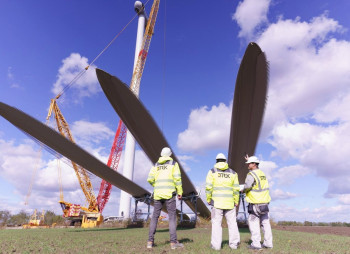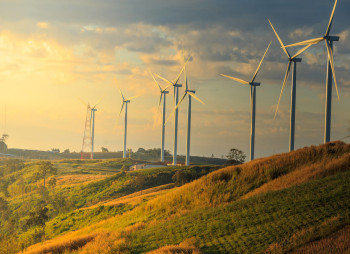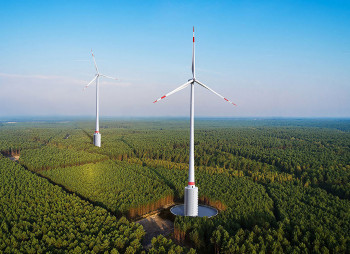TEK Group and Vestas today signed a Memorandum of Understanding to complete the construction of the largest wind farm in Eastern Europe, a project supported by the European Commission and the governments of Ukraine and Denmark.
The Memorandum of Understanding between Ukraine’s DTEK and Vestas, the world's leading manufacturer of wind turbines, stipulates that the Danish company will supply wind turbines to Ukraine for the construction of the second stage of the Tyligulska windfarm.
The second stage of the windfarm will consist of 64 wind turbines (of 6 MW each) with a total capacity of 384 MW. The first stage with a capacity of 114 MW was commissioned in the spring of 2023.
Combined, the first and second phases of DTEK Tyligulska windfarm will have a capacity of around 500 MW (83 wind turbines). The plant will be capable of generating about 1.7 TWh of electricity annually – enough for the needs of 900,000 households. It is expected the project will save 1.7 million tons of CO2 that would otherwise be emitted.
DTEK is ready to start construction of stage two in Q2 2024 and expects to complete it by the end of 2025. The installed wind turbines are expected to be gradually connected to the grid from the end of 2024.
Investments for phase two amount to 450 million euros and are to be financed by the company and leading banks under state guarantees.
The windfarm project is aligned to the broad development of distributed generation across Ukraine – a concept supported by President Volodymyr Zelenskyy. Assets such as wind turbines, which are dispersed over a wide area, have proved to be more resilient during the war and bring Ukraine closer to its ultimate goal to become a green energy hub for Europe.
The Tyligulska windfarm project was developed in accordance with the company's long-term strategy to achieve carbon neutrality and integration into the single energy market of the European Union, approved by DTEK shareholder Rinat Akhmetov.
DTEK CEO Maxim Timchenko said: "This is further evidence of Western investors’ strong confidence in DTEK Group as responsible partner in Ukraine. Believing in our victory, we will not wait for the end of the war to attract Western or our own capital to create new infrastructure. Today, we are busy restoring not only what the occupier is destroying, but also building a new energy system and new power plants. The Tyligulska windfarm will significantly increase the stability of our energy system, help strengthen the country's energy security, and enable Ukraine to become a decarbonisation leader that can act as an energy hub for Europe".
Vestas CEO Henrik Andersen said: “We are very pleased to be expanding our partnership with DTEK again and build the Tyligulska project to support the reconstruction of Ukraine’s energy sector and show that Ukraine is open for business. The project is becoming a reality under extraordinary circumstances, and we look forward to working with DTEK on the final steps towards financial closure. Infrastructure projects of this size in Ukraine currently require additional risk guarantees, and we believe supporting a project as ambitious as this can re-emphasise the EU‘s support to Ukraine. I want to recognise the visionary leadership of DTEK – thank you for the trust you have in Vestas”.
DTEK Tyligulska Wind Farm at a Glance:
Location: Mykolaiv region. 400 km from Kyiv. 85 km from the border with Moldova. 10 km from the Black Sea
First stage (completed):
The world's first wind farm built during the war
114 MW of capacity is produced by 19 Vestas EnVentus V162-6.0 MW turbines
Opened in May 2023
Cost: €200 million
The annual production of electricity is 3.9 TWh (this is enough to supply energy to 200 thousand homes)
Second stage (planned):
384 MW of capacity will be produced by 64 Vestas EnVentus V162-6.0 MW turbines
Project cost: €450 million
The construction is financed by the company and leading international banks under state guarantees.
Planned date of delivery of the first capacity: second half of 2024
Completed project:
The largest wind farm in Ukraine with an installed capacity of 500 MW
83 turbines
Total cost: c.€650 million
630 km of cables
Production of 1.7 TWh (enough to power 900,000 homes)
Estimated reduction in CO2 emissions: 1.7 million tonnes per year.






